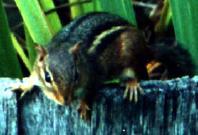

Genus: Tamias
Species: striatus

The Eastern chipmunk is a very cute little animal. It is a ground-dwelling squirrel about 5-6 inches long and weighing about 3 ounces. It is a brownish-red color. Its head has two white stripes above and below the eye. Its ears are short and rounded and stick straight up on its head. Five black stripes with white lines go down their backs. Its belly and sides are white and its tail is black above and rusty underneath. When it runs it sticks its tail straight up. It makes a sharp chattering or chucking noise when upset.
Chipmunks live in forests and edges of forests and are also found around suburban and rural areas. It has a home range of up to 1/2 acre, but will only defend an area about 50 feet around their dens. They like to rest during the day and are only active in the morning and late afternoon. They like to make their burrows in stone walls and rotting logs. The entrances to their burrows are well concealed. A burrow will have a main nesting chamber lined with leaves. Off of this chamber are several other chambers for storing food. They don't like open areas and will stay under the cover of plants whenever possible.
Although people think chipmunks hibernate, they don't go into deep hibernation. They actually move around during warmer weather. They live on the food they have brought into their burrows. Most chipmunks come out of their hibernation in March.
Eastern chipmunks will mate twice a year, in the spring and fall. Usually 2 to 5 babies are born. Babies don't open their eyes until they are 30 days old. When they are 2 months old, their mother weans them and they are on their own. A chipmunk can live to be 3 years old.
Chipmunks eat mostly what you would expect a squirrel to eat; grains, nuts, berries, seeds, and mushrooms. They also eat bugs and salamanders. They also will raid bird nests, and eat the eggs and baby birds, if they are small enough. They have a special cheek pouch in which they carry their food. Chipmunks are valuable forest creatures because they move seeds around and store them underground. Some of these seeds sprout and become new trees. They are also important as a food source for other mammals, like foxes, coyotes, crows and birds of prey like owls. The chipmunk population rises and falls with the availability of their food sources. When seeds are plentiful, the chipmunk population goes up. This means more food for foxes and other predators, so their populations go up also.
Some people think of chipmunks as pests. They eat flower bulbs, fruit and seeds. When there are a lot of them they can cause damage to stone walls, patios, stairs and foundations by burrowing under them.
The Eastern chipmunks are native to North America and can be found in the deciduous forests of southeastern Canada and the eastern United States. They are not an endangered species and can adapt to deep forest or suburban living.
2001
Bibliography:
"Eastern Chipmunk",
http://www.ag.ohio-state.edu/~ohioline/hyg-fact/1000/1034.html,
(2001).
"Eastern
Chipmunk",
http://www.wellesley.edu/Activities/homepage/web/Species/achipmunk.
html,
(2001).